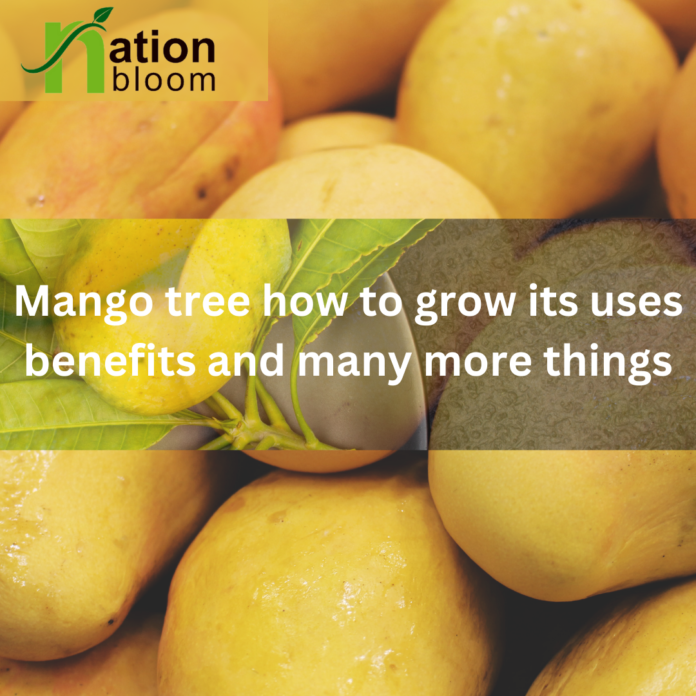Mango trees are tropical fruit trees that are grown for their sweet, juicy fruit. Here is some information on how to grow mango tree, as well as their uses, benefits, and more:
Growing a Mango Tree:
- Choose the right location: Mangoes prefer a warm and sunny location with well-draining soil.
- Select the right variety: There are many different varieties of mangoes, each with its own flavor, size, and growing requirements. Choose a variety that is suitable for your climate and growing conditions.
- Start from a seed or a sapling: You can start a mango tree from seed, but it will take several years for the tree to bear fruit. Buying a sapling will get you fruit faster, but be sure to choose a healthy one.
- Plant the mango tree: Dig a hole that is slightly larger than the root ball of the tree. Place the tree in the hole, and fill in the soil around the roots. Water well.
- Provide proper care: Mango trees need regular watering and fertilization to grow healthy and produce fruit. Prune the tree to maintain its shape and encourage branching.
Uses of Mango:
- Food: Mangoes are a popular fruit that can be eaten fresh or used in a variety of dishes, such as smoothies, ice cream, and chutneys.
- Medicine: Mango leaves and bark have been used in traditional medicine for their medicinal properties.
- Industry: Mango wood is used for furniture and construction, and the leaves are used for making baskets and mats.
Benefits of Mango:
- Rich in nutrients: Mangoes are a good source of vitamins A and C, as well as fiber and antioxidants.
- Boosts digestion: Mangoes contain enzymes that can help with digestion and alleviate digestive problems.
- Supports healthy skin: Vitamins A and C in mangoes help keep skin looking healthy and glowing.
- May lower the risk of diseases: The antioxidants in mangoes have been shown to have anti-inflammatory effects, which may lower the risk of chronic diseases such as cancer and heart disease.
Mango trees can take several years to mature and bear fruit, but they can provide a delicious and nutritious addition to your garden. With proper care, a mango tree can produce fruit for many years and can become a treasured part of your landscape.
Faqs:-
Q: What are mango trees?
A: Mango trees are tropical fruit trees that are native to South Asia and are widely cultivated for their juicy and sweet fruit, the mango. They belong to the flowering plant species Mangifera and are a popular food item in many countries.
Q: What is the ideal climate for growing mango trees?
A: Mango trees grow best in tropical and subtropical climates with high temperatures, abundant sunlight, and high humidity. They require a warm, frost-free environment and can tolerate temperatures as low as 30°F (-1°C) but will not survive prolonged cold snaps.
Q: How long does it take for a mango tree to bear fruit?
A: A mango tree typically takes about 4 to 6 years to begin bearing fruit after planting. However, the rate of fruit production can vary depending on the variety of mango, the growing conditions, and the care provided to the tree.
Q: How much space does a mango tree require to grow?
A: Mango trees can grow quite large, up to 100 feet tall, so they need plenty of room to grow. It is recommended to plant them at least 20 feet away from other trees or structures to allow for proper growth and to avoid shade.
Q: What type of soil is best for growing mango trees?
A: Mango trees prefer well-draining soils that are rich in organic matter. They are not very picky about soil pH, but they grow best in slightly acidic soils with a pH of 6 to 7.
Q: How often should I water my mango tree?
A: Mango trees require regular watering, especially during hot and dry weather. Watering frequency will depend on the soil type and weather conditions, but it is generally recommended to water the tree once or twice a week. Overwatering can lead to root rot, so it is important to make sure the soil is well-drained.
Q: How do I prune my mango tree?
A: Pruning is important to promote healthy growth and fruit production in mango trees. It is best to prune the tree in the late winter or early spring, just before the start of the growing season. Pruning should be done to remove dead or damaged branches, to shape the tree, and to control its size.














